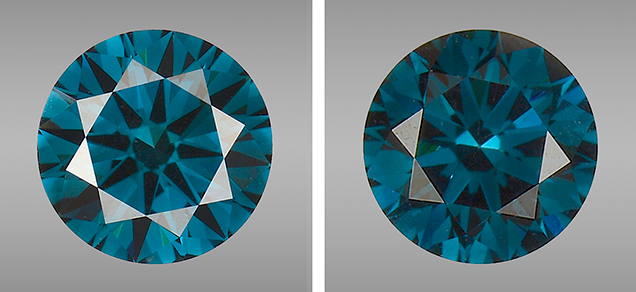Irradiated Green-Blue CVD Synthetic Diamonds

As-grown CVD synthetic diamonds are routinely treated in order to create attractive colors. Irradiated CVD synthetic diamonds without a multi-step treatment process are rarely seen in the lab, though an irradiated Fancy Deep gray-blue CVD synthetic has been reported (Fall 2014 Lab Notes, pp. 240–241). The New York lab recently examined two such examples: a 0.64 ct Fancy Deep green-blue and a 0.43 ct Fancy Deep greenish blue specimen (figure 1).

Dark inclusions, faint color bands, and chips on the girdle were observed in both specimens under the microscope. Tatami-like strain was also seen in both diamonds under cross-polarized light. DiamondView images revealed parallel green linear striations in the pavilions (figure 2). Face-up DiamondView images also showed yellowish green zones, which were formed by growth interruptions (again, see figure 2). Both stones were pure type IIa diamonds with no other defects in the IR spectra. High-resolution UV-Vis-NIR absorption spectra detected Si-V center defects at the 736.5–736.9 doublet (737 nm center, (V-Si-V)–); the spectra also revealed radiation-related peaks at 393.5, 464.3, 469.9, 594.2, 666.5, 735.8, and 741.2 nm (figure 3). The 393.5 band is from the ND1 center, a negatively charged vacancy (V–). An intrinsic radiation center (TR12) was detected at 469.9 nm. The TR13 center at the 464.3 peak is a local vibrational mode associated with the TR12 center, and the 594.2 band (595 nm center) is a typical radiation-induced center. The 666.5 peak is attributed to a neutral self-interstitial (I0) defect. The 735.8 band, also caused by the I0 defect, is related to the 666.5 band. Strong absorption from the GR1 center, which contains neutral vacancies (V0), was detected at 741.2 nm. All these radiation-related peaks can be destroyed by HPHT treatment, while peaks at 666.5 and 735.8 nm can be annealed out at temperatures ranging from 420º to 540ºC (see A.T. Collins, “Spectroscopy of defects and transition metals in diamond,” Diamond and Related Materials, Vol. 9, Nos. 3–6, 2000, pp. 417–423). The presence of these peaks indicates that these CVD synthetics were either annealed at lower temperatures (420º to 540ºC) or irradiated without annealing.

Although microscopic features such as strain pattern can be helpful in the identification of CVD synthetics, they are not conclusive. DiamondView imaging is very useful for this purpose due to its ability to detect linear striations. As CVD growth techniques continue to improve, we anticipate that intensely colored, high-quality CVD synthetic diamonds will become more prevalent in the trade.



